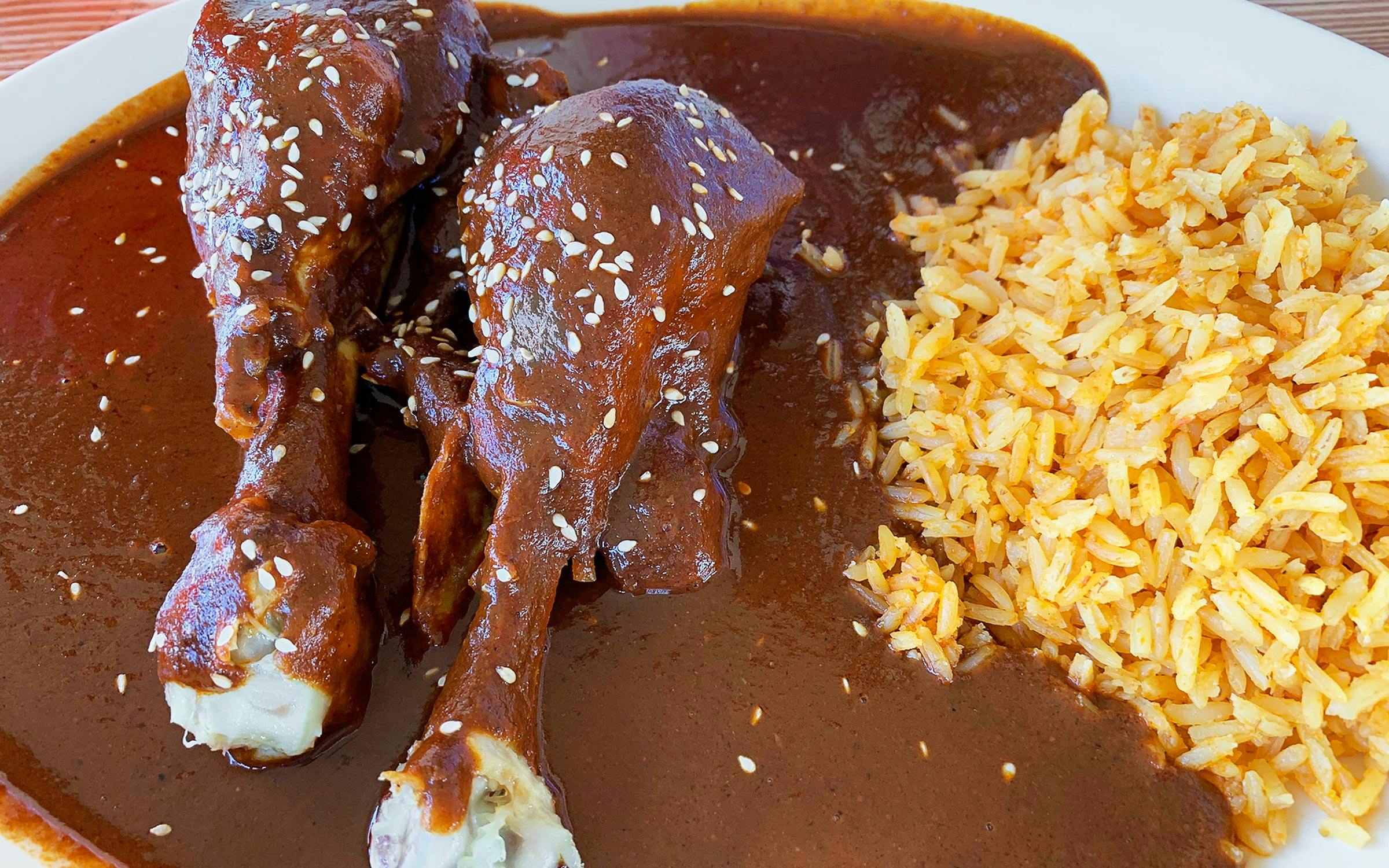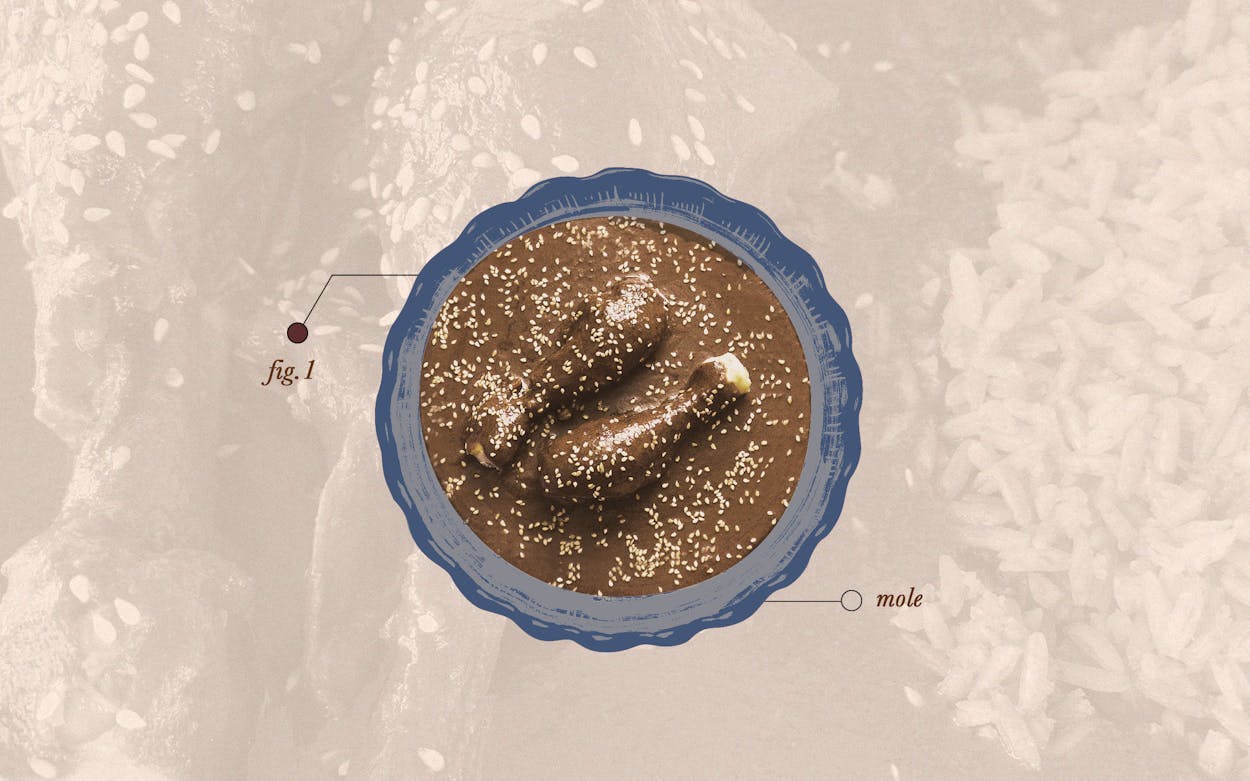It’s one of the most sought-after and beloved Mexican dishes. It’s considered one of the best expressions of traditional Mexican gastronomy, if not its pinnacle. For most American diners, though, it’s limited to mole poblano or mole oaxaqueño. Both variations are named for the parts of Mexico from which they hail, and often served over chicken breasts or enchiladas. But mole is much more. Contrary to popular belief, most preparations of the classic dish don’t include chocolate. Mole is as diverse as the homes and restaurants across Mexico and the United States in which its many iterations are coaxed to life.
There are two essential moments for me when it comes to mole. It was in 2015 when I first truly appreciated the dish. I had walked into the now closed Mi Lindo Oaxaca. I watched in awe as owner Honorio Garcia, his brother, and their staff hand-shelled the cacao beans to make the chocolate that would go into the house-made mole oaxaqueño. If any other Dallas restaurant then or now prepares its mole with the same attention to detail and tradition, I will be shocked. Garcia gladly escorted me into the kitchen and permitted the recording of a video of Mi Lindo’s process. The finished product was a stunning, well-balanced platter of chicken drumsticks dressed in a shawl of mole. For me, witnessing its preparation revealed the magic, complexity, and expertise behind great mole.
Two years later, mole blew my mind again. At a culinary symposium in Mexico City, I had perhaps the best mole I’ve ever tasted: a mole de manzana (apple mole). Served in a chewy, blue corn quesadilla, the dish was an exciting, chunky mess of shredded pork, with arteries of corn masa in a mass of verdant mole. The meal told a flavorful story: it went from sweet and grassy to tart and rich to spicy. Somehow, it all came together in a harmonious finish. Every great mole takes the diner on the same journey.
It’s been that way for nearly two thousand years. Mole’s tale begins with its indigenous Nahuatl root word, mōlli, which translates to “sauce.” However, mole is not just a sauce, but rather the entire main dish. Its murky origins are commonly traced back to a tale about a nun at the Convent of Santa Rosa in Puebla, Mexico, in the late 1600s. The nun, Sor Andrea de la Asunción, was charged with cooking a fancy meal in honor of a visit from the viceroy of New Spain, now Mexico. “She was cooking turkey with some sauce when a holy wind blew in the kitchen and threw some spices, chocolate, and chiles in the dinner sauce,” recounts Iliana de la Vega, chef and co-owner of El Naranjo, in Austin. “It was too late to prepare another dish, so she had to serve it. Everybody loved it.” And thus, according to myth, mole was born.
Of course, it’s unclear if any of this is true, and de la Vega doesn’t take the story as gospel. Like Mexico itself, mole is a conglomeration of Mesoamerican and colonial elements that clasps the taster’s tongue like a parent holds a child’s hand while crossing the street. There must be trust and a willingness to see what awaits across the way. There is a sense of adventure in place and time and tradition. Take Houston chef Hugo Ortega, whose restaurants include upscale Oaxacan Xochi and the legendary Hugo’s. Ortega is a native of the Puebla-Oaxaca border, and a mole philosopher-experimenter. Although he thinks the origin myth has a seed of truth, he sees mole as a canvas for trying new things. “Am I going to come up with a recipe like [mole poblano]? Absolutely not,” he says. “Yes, I can put a bunch of ingredients together and try to imitate mole. But why?” Rather, he’s guided by which ingredients are fresh and in season in Texas at the time: “I apply what I know with the ingredients I can get.” Ortega also considers which chiles and other components will work well together. For example, is a certain chile too sharp? Would adding plantain give the finished mole a silky texture to benefit the dish? Does a mole really need 19, 21, or 36 ingredients? The latter is a common misconception.

Ortega then conjures wildly creative moles to put on his restaurants’ menus. He’s made a fig mole, a cherry mole, and even a mango mole. Xochi has a mole-tasting platter of rotating selections, which I urge you to request when you visit the downtown dining establishment. But perhaps one of my favorite Xochi moles is the mole de chicatanas, a bold, addictive preparation made with a base of flying ants, a Oaxacan delicacy, paired with pork ribs. Fresh, nixtamalized in-house tortillas are served on the side. Save some for sopping up the last of the mole.
The dish is laborious and difficult to make, as must be any worthwhile journey. It demands patience—sometimes years to master and days to prepare. It’s not so much about the number of ingredients, but more about the balance of flavors and the process of cooking. The mole negro at El Naranjo takes three days to finish. “It took me about two years to decide to put mole negro on the menu, but it has been always our best-selling dish,” de la Vega says of the recipe she learned from her mother and aunts and has tweaked over her career. The chef considers the Oaxacan mole the best in existence. It’s a complex mixture whose sweetness has masterful restraint imparted by plantains, chocolate, and raisins. “There are a couple of ingredients that are difficult to get but not impossible. Making mole is a labor of love,” she says.
That idea is echoed by Gabe Erales, former Comedor executive chef and a contestant on season eighteen of Bravo’s Top Chef. Erales has spent years honing his mole technique, and he says he’s learned from many chefs along the way. He recognizes Oaxaca-based cooking instructor Susana Trilling as his biggest influence. “She further refined what I like to refer to as a layering technique, where ingredients are processed and cooked separately before all being brought together to be cooked together for a long period of time to develop more flavor,” Erales says. At Comedor, his fruit-forward mole manchamanteles (literally, “tablecloth-stainer mole”) was a powerful mole that paired well with pork. The mole was developed in part by utilizing the seasonality of Texas fruit. The mole verde was a bright and herbaceous dish that perfectly complemented seafood and vegetables.
Mole requires specific ingredients, some rare, and therefore the dish can be intimidating for cooks and diners alike. Erales puts it simply when he says that the biggest challenge for making mole in Texas—or anywhere in the U.S., for that matter—is sourcing quality dried chiles. But that’s changing. “With the rising popularity of Mexican cuisine, more and more companies are being born that import high-quality chiles from different regions of Mexico,” Erales says. That means mole, in all its expansive varieties, has a promising future in Texas and beyond.
- More About:
- Tex-Mexplainer
- Tacos
- Houston
- Dallas
- Austin








